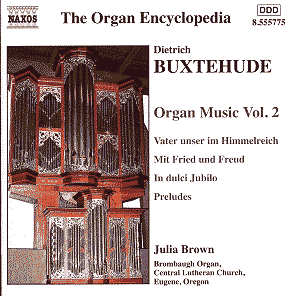This is, and I have an unnatural tendency to feel slightly
alarmed by this, one of an ongoing Naxos series entitled ‘The
Organ Encyclopaedia’. Completism strikes again! Of course Buxtehude,
who is quite certainly an important figure, will fill a number
of volumes. This one is a follow up to Volume One, by Volkar Ellenberger
and that disc, it must be said, has on it longer and more substantial
works.
Buxtehude was a leading figure in North Germany
in the years before J.S.Bach and influenced the great man in many
ways. I have often thought that he must have been quite exceptional
to warrant J.S. walking, so it’s said, the quite considerable
distance from Arnstadt where Bach worked under some difficulty
in the years 1703-6 aged about 20, to Lubeck to hear Buxtehude
play. Bach’s absence did not endear him to his overlords, but
he wanted to hear Buxtehude play a series of Sunday evening recitals
during Advent. In the event Bach stayed longer than he should
have done, utterly captivated by the older musician’s performances.
Yet it must be remembered that at that time Buxtehude
and Bach and other organists were primarily known as improvisers.
They were known secondly as organists and thirdly as composers.
In listening to this CD I have to say that that order makes sense,
as none of this music is exceptional although it is well crafted
and certainly interesting.
The organ, a picture of which adorns the cover,
is a three-manual affair. It is called the Brombaugh Organ, in
the Central Lutheran Church at Eugene in Oregon. It was built
in 1976. Amongst its stops is an intriguing coupler called a ‘Nightingale’.
Now I may be mistaken, but can I hear it chirruping away at the
end of track 18, the choral fantasy suitable for epiphany on ‘How
brightly shines morning stars’ (Wie schön leuchet der morgenstern’)?
It was a good idea to frame the disc with the
free but fugal ‘Praeludium’ in C major and the one in A minor
the latter ending in the major bringing the disc to a bright conclusion.
Buxtehude’s Fugues are not as developed or as clever as Bach’s
but it is quite clear that Bach must have studied them, especially
a work like ‘Mit Fried und Freud ich fahr dahin’. This was written
for a funeral for a local dignitary in 1671 and consists of a
‘Contrapunctus I’ with the choral in the upper voice, the ‘Evolutio
I’ with the tune in the pedals, ‘Contrapunctus II’ with melody
in the upper part and with the lower parts swapped over, ‘Evolutio
II’ with all parts inverted and a final moving ‘Klag-lied’ added
later for his own father’s funeral. I feel that this is the best
piece on the disc.
There are preludes on hymn tunes and Lutheran
chorales and a fine Ciaccona with a short Toccata but little else
that stands apart. The best-known work is the brief fantasy on
‘In dulci jubilo’.
Whilst Buxtehude’s music is not particularly
virtuoso it is not straightforward to interpret either. It looks
fairly simple on the page but is deceptive in its demands. It
needs a thoughtful choice of registration. Praise then goes to
Julia Brown who uses the organ to its fullest extent. Particularly
interesting is the versus II of the ‘Vater unser im Himmelreich’
chorale variations with its curiously jumpy two part texture demanding
a woodwind stop in a left hand of agility and clarity. This she
achieves with, I think, an 8ft Dulcian; beautifully captured too
in this vivid recording.
I wonder if Keith Anderson could go down as the
most prolific writer of booklet notes in history. Here we have
another fascinating essay on Buxtehude together with good, helpful
analyses of each piece. All well up to his usual excellent standard.
Gary Higginson
